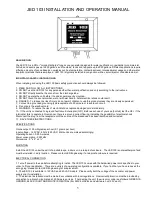
26
User’s Guide ADI-2 DAC
© RME
14.1.2 Clock
The subpage
Clock
has the following entries:
Clock Source
Shows the current clock source INT (internal), optical or
SPDIF coaxial. The clock source is automatically
determined and set by the unit, a selection is neither
possible nor necessary. With USB the internal clock is
used, with SPDIF the external one.
Sample Rate
The sample rate is also automatically determined and set
by the unit. With USB the current sample rate of
record/playback is set (INT), with SPDIF the sample rate of
the SPDIF signal (Optical/SPDIF c).
ADAT input signal: The automatic clock control requires the ADAT data stream to include
SMUX2 indication, in case of 88.2 and 96 kHz sample rate. As there is no indication for 176.4
and 192 kHz (SMUX4), these sample rates are not supported with ADAT.
The unit's internal clock supports 44.1, 48, 88.2, 96, 176.4, 192, 352.8, 384, 705.6 and 768 kHz.
When clocked externally the ADI-2 DAC will recognize and handle other frequencies for DA
conversion as well, for example 32, 64 and 128 kHz. In the lowest line the DSD rate equalling
the current sample rate is shown.
14.1.3 Device Mode
The subpage
Device Mode
has the following entries:
Mute Line
OFF, vs. Phones, Toggle Ph/Line. Default: vs. Phones.
Activates mutual mute between Phones/IEM out and rear
Line Out. Default is mute of Line Outs when inserting a
phones or IEM plug. Alternatively Toggle activates the ability
to manually switch between 'front' and 'rear'. This allows to
have the phones/IEM connected all the time. To change
push the VOLUME knob for half a second. This function can
also be controlled by one of the four function keys or the
remote control via Remap Function Keys.
DSD Direct (Line)
OFF, ON. Default: OFF. When activated a DSD playback will use DSD Direct mode over the
rear outputs 1/2. As DSD Direct bypasses all DSP calculations and volume control, the only
way to change the output volume is by setting different reference levels. Therefore in DSD Di-
rect mode outputs Phones and IEM are disabled.
DSD Filter
When DSD Direct mode is active, high-frequency noise filters help to reduce such noise, which
is quite high in level and might have negative impact on other equipment. While 50 kHz is opti-
mized for DSD64 and 150 kHz for DSD 128 and 256, the user can freely try both at any DSD
rate.
DSD Detection
Default: ON. Option to deactivate the automatic DSD detection on SPDIF and USB.
Summary of Contents for ADI-2 DAC
Page 9: ...User s Guide ADI 2 DAC RME 9 5 4 Overview Menu Structure...
Page 17: ...User s Guide ADI 2 DAC RME 17 User s Guide ADI 2 DAC Operation Controls and Display...
Page 33: ...User s Guide ADI 2 DAC RME 33 User s Guide ADI 2 DAC Inputs and Outputs...
Page 37: ...User s Guide ADI 2 DAC RME 37 User s Guide ADI 2 DAC Installation and Operation Windows...
Page 42: ...42 User s Guide ADI 2 DAC RME...
Page 43: ...User s Guide ADI 2 DAC RME 43 User s Guide ADI 2 DAC Installation and Operation Mac OS X...
Page 46: ...46 User s Guide ADI 2 DAC RME...
Page 47: ...User s Guide ADI 2 DAC RME 47 User s Guide ADI 2 DAC Installation and Operation iOS...
Page 49: ...User s Guide ADI 2 DAC RME 49 User s Guide ADI 2 DAC Technical Reference...
Page 54: ...54 User s Guide ADI 2 DAC RME 31 4 Filter Curves 44 1 kHz 31 5 Frequency Response...
Page 56: ...56 User s Guide ADI 2 DAC RME 31 7 Total Harmonic Distortion Measurements 31 8 Loudness...
Page 57: ...User s Guide ADI 2 DAC RME 57 31 9 Extreme Power Charts...
Page 64: ...64 User s Guide ADI 2 DAC RME 31 16 Block Diagram...
Page 65: ...User s Guide ADI 2 DAC RME 65 User s Guide ADI 2 DAC Miscellaneous...
















































